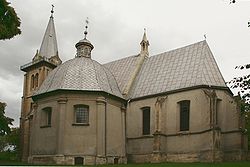Działoszyce
| Działoszyce | ||
|---|---|---|

Holy Trinity Church
|
||
|
||
| Coordinates: 50°22′N 20°21′E / 50.367°N 20.350°E | ||
| Country |
|
|
| Voivodeship | Świętokrzyskie | |
| County | Pińczów | |
| Gmina | Działoszyce | |
| Area | ||
| • Total | 1.91 km2 (0.74 sq mi) | |
| Population (2006) | ||
| • Total | 1,068 | |
| • Density | 560/km2 (1,400/sq mi) | |
| Postal code | 28-440 | |
| Car plates | TPI | |
| Website | http://www.dzialoszyce.pl | |
Działoszyce [d͡ʑawɔˈʂɨt͡sɛ] is a town in Świętokrzyskie Voivodeship, Poland, with 1,117 inhabitants (2004). It is located in historic Lesser Poland, and the earliest mention of Działoszyce in historical records comes from 1220. In 1409 King Władysław II Jagiełło gave it a city charter (see Magdeburg rights). According to the 1921 census the town had a Jewish community consisting of 5618 people, or 83.6 percent of its total population. The vast majority of the Jewish population was exterminated in the Holocaust by German Nazis during their occupation of Poland. After the war, Jewish survivors from Działoszyce submitted contributions to a Memorial Book (Yizkor Book). In subsequent years the town's population did not recover, and today it is less than one fifth of what it was before the war.
Działoszyce, located on the Nidzica river (a tributary to the Vistula), was in the Middle Ages placed along a merchant route from Kraków to Wiślica. The settlement prospered due to the protection of bishop of Kraków Iwo Odrowąż, and King Kazimierz Wielki. In 1409, Działoszyce was granted Magdeburg rights by King Władysław Jagiełło. The town was part of Lesser Poland’s Sandomierz Voivodeship, and it belonged to the Ostrogski family, which collected tolls for crossing the river bridge. In the Polish-Lithuanian Commonwealth, Działoszyce was a local trade and craft center. In 1629 the town had 13 artisans, and a mill. In 1662 it had 468 inhabitants, and the right to organize 12 fairs a year. In 1795, following the Partitions of Poland, Działoszyce was first annexed by Austria, and in 1807 it passed on to the Duchy of Warsaw (since 1815 - Russian-controlled Congress Poland). At that time, the number of Jewish settlers increased in the town, and by 1820, it had 1692 inhabitants, 74% of whom were Jews.
...
Wikipedia


